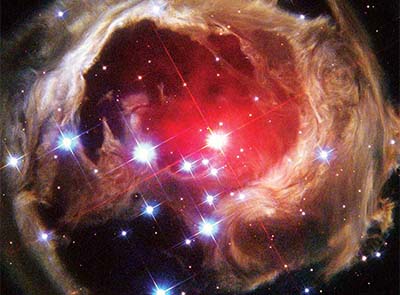A binary star that merged and exploded almost 2 000 years ago will be visible from earth within the next couple of years.
Calvin College professor Larry Molnar and his students along with colleagues from Apache Point Observatory (Karen Kinemuchi) and the University of Wyoming (Henry Kobulnicky) are predicting that the change to the night sky will be visible to the naked eye.
“It’s a one-in-a-million chance that you can predict an explosion,” Molnar says of his bold prognostication. “It’s never been done before.”
Molnar’s prediction is that a binary star (two stars orbiting each other) he is monitoring will merge and explode in 2022, give or take a year; at which time the star will increase its brightness ten thousand fold, becoming one of the brighter stars in the heavens for a time.
The star will be visible as part of the constellation Cygnus, and will add a star to the recognizable Northern Cross star pattern.
Molnar’s exploration into the star known as KIC 9832227 began back in 2013. He was attending an astronomy conference when fellow astronomer Karen Kinemuchi presented her study of the brightness changes of the star, which concluded with a question: Is it pulsing or is it a binary?
Also present at the conference was then Calvin College student Daniel Van Noord ’14, Molnar’s research assistant. He took the question as a personal challenge and made some observations of the star with the Calvin observatory.
“He looked at how the colour of the star correlated with brightness and determined it was definitely a binary,” says Molnar. “In fact, he discovered it was actually a contact binary, in which the two stars share a common atmosphere, like two peanuts sharing a single shell.
“From there Dan determined a precise orbital period from Kinemuchi’s Kepler satellite data (just under 11 hours) and was surprised to discover that the period was slightly less than that shown by earlier data.”
Molnar and colleagues will be observing KIC 9832227 in the next year over the full range of wavelengths: using the Very Large Array, the Infrared Telescope Facility, and the XMM-Newton spacecraft to study the star’s radio, infrared and X-ray emission, respectively.
“If Larry’s prediction is correct, his project will demonstrate for the first time that astronomers can catch certain binary stars in the act of dying, and that they can track the last few years of a stellar death spiral up to the point of final, dramatic explosion,” says Matt Walhout, dean for research and scholarship at Calvin College.
“The project is significant not only because of the scientific results, but also because it is likely to capture the imagination of people on the street,” Walhout adds. “If the prediction is correct, then for the first time in history, parents will be able to point to a dark spot in the sky and say, ‘Watch, kids, there’s a star hiding in there, but soon it’s going to light up’.”
Molnar says this is the beginning of a story that will unfold over the next several years, and people of all levels can participate.
“The orbital timing can be checked by amateur astronomers,” says Molnar. “It’s amazing the equipment amateur astronomers have these days. They can measure the brightness variations with time of this 12th magnitude star as it eclipses and see for themselves if it is continuing on the schedule we are predicting or not.”
Pictured: A red nova explosion; pic from the Space Telescope Science Institute

